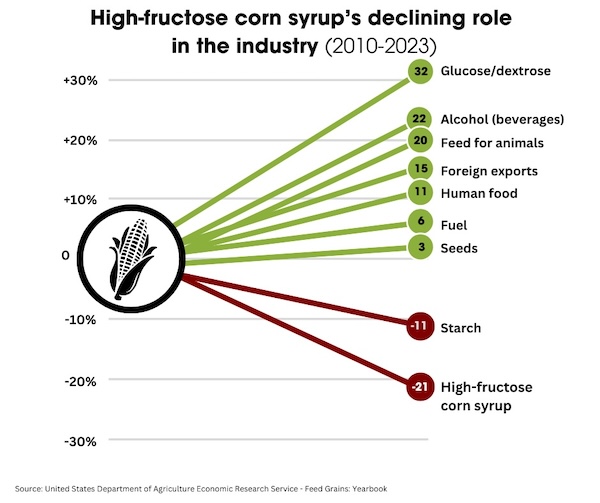The debate over “high-fructose corn syrup” (HFCS) has been back in the headlines the past couple of weeks as Coca Cola moves to start offering Coke with natural sugar in the U.S. The sugar replacement has long been blamed for America’s obesity problem and corresponding health issues, such as diabetes and heart disease. That’s despite decades of research finding no significant differences between real sugar and HFCS.
High-fructose corn syrup (HFCS) is a sweetener made from cornstarch, where some of the glucose is converted to fructose. It’s commonly used in processed foods and beverages because it is less expensive and has a longer shelf life than natural sugar. The cost factor is not insignificant, either. Cane sugar can be anywhere from around +30% to +150% more expensive per pound than HFCS.
HFCS was first marketed in the U.S. in the early 1970s by the Clinton Corn Processing Company, together with the Japanese Agency of Industrial Science and Technology. The Japanese agency played a key role in discovering the enzyme that converts glucose to fructose, a crucial step in HFCS production.
Since then, HFCS has become a major product of the U.S. corn industry. U.S. food manufacturers began replacing sugar with HFCS in the 1970s, though production improvements helped it gain more traction starting in the 1980s. This was supercharged in part by U.S. government quotas and tariffs on imported sugar and growing subsidies for domestic corn.
Domestic production of HFCS increased from 2.2 million tons in 1980 to a peak of 9.5 million tons in 1999. Production has settled around 7.5 million tons in recent years. Corn produced for HFCS in the 2023/24 crop year totaled around 410 million bushels, representing a decrease of approximately -21% since 2010.
The debate over whether HFCS is harmful to human health has been around almost as long as the ingredient itself. U.S. Health and Human Services Secretary Robert F. Kennedy Jr. sits solidly in the camp that believes HFCS is “poisoning” Americans. However, health experts generally say the real issue is not the ingredients themselves but rather our overconsumption of all types of sweetened foods and beverages.
Sugar consumption has risen more than 40-fold since the Declaration of Independence was signed 250 years ago, and more than 40% of the added sugars in our diet come from sweetened beverages and fruit drinks. The intake of soft drinks has risen fivefold since 1950 and with it the intake of HFCS.
The rise in the consumption of high-fructose corn syrup in beverages has paralleled the rise in the prevalence of obesity and other health issues associated with the intake of sugars. However, this association does not prove causation and there is little evidence to support claims that HFCS poses health risks different from those caused by the overconsumption of sugar.
Coca-Cola’s original formula, dating back to the 19th century, did use cane sugar, but that began to change during the late 1970s and early 1980s as sugar costs in the U.S. climbed and HFCS became more widespread. The company completed its transition from sugar to HFCS in U.S. products in 1984.
However, Coca-Cola does still use real sugar in most markets, including Mexico and EU countries, similar to other beverage makers. In many of these markets, use of GFS in soft drinks is limited because manufacturers do not have a sufficient supply of GFS containing at least 42% fructose content. As a result, soft drinks are primarily sweetened by sucrose (real sugar) which has a 50% fructose content. In fact, global manufacturers still use real sugar to sweeten more than 90% of beverages worldwide. (Sources: Corn Growers Association, Investigate Midwest, NIH, Fortune)









Pingback: Coca-Cola Confirms New Recipe After Donald Trump Makes Shocking Claim He’s Changing It